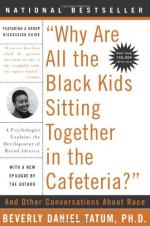
|
| Name: _________________________ | Period: ___________________ |
This test consists of 5 multiple choice questions, 5 short answer questions, and 10 short essay questions.
Multiple Choice Questions
1. What refers to a similarity between like features of two things, on which a comparison may be based?
(a) Analogy.
(b) Phyllogism.
(c) Redundancy.
(d) Allegory.
2. What does Tatum define as a system of advantage based on race which restricts access to power and privilege?
(a) Class.
(b) Racism.
(c) Alienation.
(d) Meritocracy.
3. Tatum explains that much of the pattern of stability and transition in midlife creates pressures on racial identities for Blacks where in Part II, Understanding Blackness in a White Context, Chapter 5, Racial Identity in Adulthood?
(a) In the workplace.
(b) In school.
(c) In the home.
(d) In public.
4. What groups benefit from systems of racism (and other isms), according to the author?
(a) Fringe groups.
(b) Political groups.
(c) Dominant groups.
(d) Radical groups.
5. While studying at university, Tatum had what Cross describes as what kind of experience?
(a) Conversion.
(b) Adversion.
(c) Nationalism.
(d) Immersion.
Short Answer Questions
1. In Part II, Understanding Blackness in a White Context, Chapter 5, Racial Identity in Adulthood, Tatum reports that she did not sit at the Black table in her cafeteria for what reason?
2. The first African slaves were brought to Jamestown, Virginia in what year?
3. What refers to the state or fact of being different or distinct?
4. Beverly Daniel Tatum received an M.A. in religious studies from which institution?
5. Beverly Daniel Tatum is currently the president of what educational institution?
Short Essay Questions
1. How does the author define prejudice in Part I, A Definition of Terms, Chapter 1, Defining Racism? What does revealing prejudice require?
2. How does Tatum relate prejudice to racism in Part I, A Definition of Terms, Chapter 1, Defining Racism?
3. At what age does the author assert children begin to recognize race in Part II, Understanding Blackness in a White Context, Chapter 3, The Early Years? What does Tatum encourage parents to do at this stage?
4. What does the author assert is needed in order to overcome racial prejudices in identity in Part II, Understanding Blackness in a White Context, Chapter 4, Identity Development in Adolescence?
5. What is Tatum's argument against those who suggest keeping silent regarding race with children in Part II, Understanding Blackness in a White Context, Chapter 3, The Early Years?
6. How does the author distinguish between dominant and subordinate groups in Part I, A Definition of Terms, Chapter 2, The Complexity of Identity?
7. What two developmental stages does Tatum focus on in adolescent development of identity in Part II, Understanding Blackness in a White Context, Chapter 4, Identity Development in Adolescence?
8. How does Tatum describe the stages of racial identity for blacks in Part II, Understanding Blackness in a White Context, Chapter 5, Racial Identity in Adulthood?
9. How does Tatum describe racial identity in relationship to religion in Part II, Understanding Blackness in a White Context, Chapter 5, Racial Identity in Adulthood?
10. How does the author address the subject of slavery when dealing with children in Part II, Understanding Blackness in a White Context, Chapter 3, The Early Years?
|
This section contains 966 words (approx. 4 pages at 300 words per page) |

|




